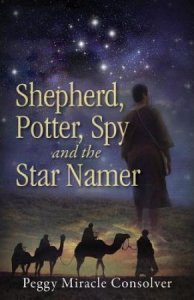The Day the Sun Stood Still: Novel Takes a Fresh Look at the Hebrew People as Told by Those Inside Canaan When the Israelites Take the Promised Land
 Contact: Joni Sullivan Baker, Buoyancy PR, 513-319-3231, jbaker@buoyancypr.com
Contact: Joni Sullivan Baker, Buoyancy PR, 513-319-3231, jbaker@buoyancypr.com LOVELAND, Ohio, Sept. 27, 2016 /Standard Newswire/ -- Bible times and people leap from the page in the hands of first-time author Peggy Miracle Consolver in her new novel, Shepherd, Potter, Spy—and the Star Namer.
This book paints the story of the mysterious Hebrew people from a fresh vantage point, that of one of the Canaanite cities whose people watch in fear and awe as the Hebrews approach the Promised Land.
The book is so well researched it received an endorsement from a noted Bible scholar. There's even an accompanying interactive study guide releasing October 1 that will bring the story alive for a digital generation.
Suitable for middle schoolers to adults, Consolver weaves a deeply moving tale from the Biblical account of the Gibeonites' deceiving the Hebrews' in Joshua 9 and 10, adding color, texture and context that will deepen every Bible reader's understanding.
The story is told through the eyes of a 12-year-old Gibeonite boy, Keshub. In the beginning, alone with his sheep, he yearns for a life beyond his valley while he practices thrusts and lunges with his wooden sword against an unseen enemy. In the end, Keshub saves the day with a real sword on the day the sun stands still.
Along the way, Consolver paints word pictures ranging from the warmth of sun-drenched stones to the deep amber eyes and beautiful eyelashes of a camel, from the stickiness of honey on a boy's hands, to the color of the tunic his mother made him and the plants that provided dyes for each color.
The story also provides vignettes of life on the "other side" as Joshua and his family experience the final year of the 40 years in the wilderness.
Consolver introduces us to ideas about how the Israelites might have prepared manna, as well as to the fact that the word manna means "What is it?"
The interactive study guide offers links so that readers can see the actual land and river, watch how-to videos for using a slingshot or making a bow, and even learn what the bear Keshub faced would have looked like.
"It was so exciting for me to see the river and the high bluff over Jericho, I wanted my readers to see it too," Consolver said.
"Like an archaeologist who digs for buried treasure in ancient sites, the study guide will show the reader where to dig to uncover new insights into the land of the Bible and this Late Bronze Age event," says Consolver. "I realize it's not common for a novel to have a study guide," she adds. "But learning more about these people and their way of life shows us these were real people in God's story, people like us. This helps us see God works in our lives, too."
In writing her first novel, she draws on 14 years of Bible study using a chronological reading plan. She says it was while immersed in that study that the story of the Gibeonites bubbled to the surface and began to take shape.
Working on an archaeological dig in the Palestinian West Bank and an in-depth study of the Bible inform her writing, as does her own background. Consolver grew up on a wheat farm in southwest Oklahoma, one of six kids who were all expected to work and contribute, and likely all jostling for attention in a similar way to Keshub's large extended family. Her knowledge of plants and animals adds further detail to the story.
A Dallas-area resident, Consolver has taught Sunday school for 37 years and is a speaker and Design Consultant in Texas Garden Clubs. She and her husband have two children and five grandchildren.
Shepherd, Potter, Spy -- and the Star Namer [ISBN: 978-1-942587-9-5] was published by Carpenters Son Publishing.
The interactive study guide, Digging Deeper Into HIStory: A Study Guide for Shepherd, Potter, Spy—and the Star Namer will be available as an e-book with links and also in print.
Both books are available wherever fine books are sold and from Amazon and other online retailers.
For review copies or to interview Peggy Consolver, contact Joni Sullivan Baker, Buoyancy PR, at 513/319-3231 or jbaker@buoyancypr.com.
MORE ABOUT THE STORY:
In the beginning, alone with his sheep, 12-year-old Keshub, the fifth son of a potter, dreams about life beyond his valley while he practices thrusts and lunges against an unseen enemy with his wooden sword.
In the end, Keshub saves the day with a real sword on the day the sun stood still.
He hears about the mysterious Hebrew people as kings in Canaan build their armies. When he moves from shepherding to traveling to Jerusalem and Jericho to help sell his family's pottery, Keshub sees for himself the impact the Hebrews are having in Canaan.
As tensions mount and the Israelites draw near, he is thrust into the role of a spy watching from the height of the ridge above the Hebrew camp at Gilgal. From there Keshub becomes a witness and a key player on the day Joshua asks for the sun to stand still.
Keshub's family does not know the Hebrews' God, but they and the Gibeonites refuse an alliance with neighboring city-states steeped in idol worship and child sacrifice to a god they deem to be no god at all. As the Hebrew horde is poised to invade, and as Gibeonite spies report the events unfolding, the potter becomes convinced the Hebrew God fights their battles for them.
Not knowing if they will live or die, the Gibeonites seek an alliance with the enemy whose God made the flooded waters of the Jordan pile up so they could cross and brought down mighty Jericho with a shout.
For a long time, the potter and his family had a hope there is a god who watches over them--the one who named the stars. Can the Hebrew God be the Star Namer?




 Sign Up to Receive Press Releases:
Sign Up to Receive Press Releases: